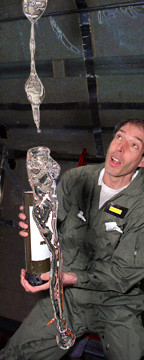 Scenario:
Scenario: Experimenters burst water balloons in the low-gravity environment produced aboard a NASA Glenn DC-9 aircraft.
The tests were conducted in part to develop the ability to rapidly deploy large liquid drops by rupturing an enclosing membrane. As can be seen from the experiment footage, the initial rupture process is nearly ideal, but the finite size of the balloon material eventually ejects a spray from the drop surface. Then, when the balloon material leaves the drop entirely, it causes a large deformation of the drop (blob) which oscillates throughout the remainder of the test. Calculations suggest that such oscillations will continue for hours before the drop eventually becomes spherical. Highspeed photographs of punctured Water Balloons in a Lab were also taken.
The airplane flies parabolic trajectories approximately 8000ft in height which provide up to 25 seconds of low-gravity time within which researchers can perform experiments to investigate low-gravity phenomena.
| Downloadable Videos |
| An approximately 3L water-filled balloon is ruptured simultaneously at opposite ends using syringe needles. [A syringe needle causes a slice-type rupture which proceeds along a desired path.] | |
| Red-dyed, water-filled balloon rupture. Blue-dyed water is injected into the blob with increasing force. | |
| Experimenter blows large air bubble into the free floating blob using a straw. The test was captivating enough that no effort was made to 'bag the blob' prior to the end of the low-g period. | |
 Scenario:
Scenario: 
0 Comments:
Post a Comment
<< Home